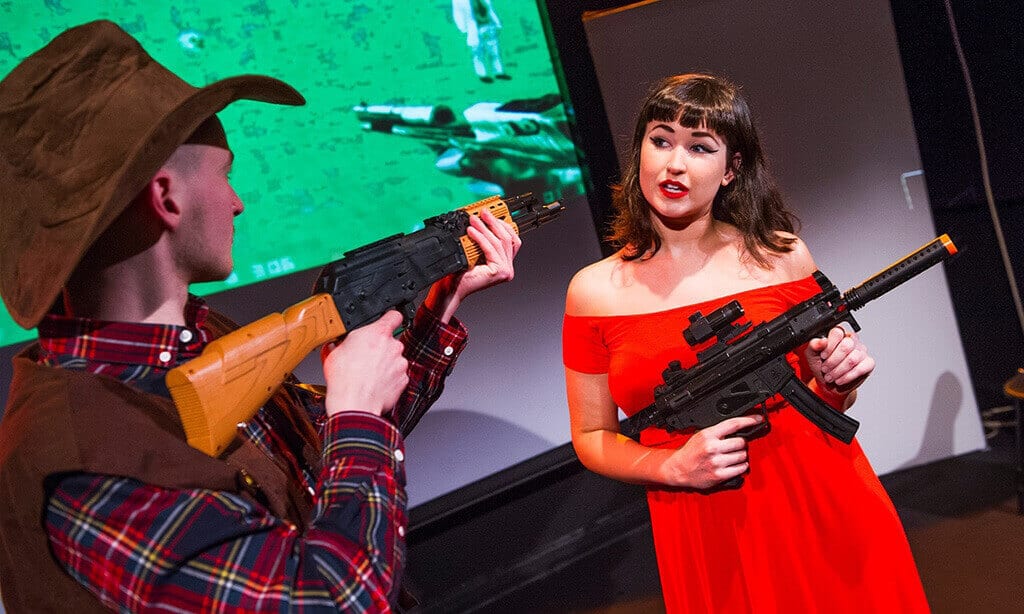A Girl and A Gun is titled after a quotation widely attributed to Swiss-French fimmaker Jean-Luc Godard: all you need to make a movie (successful) is a girl and a gun. “It was [D. W.] Griffith who said that, not me,” Godard always insisted, but there is too much truth to the statement for its origin story to matter. At the Camden People’s Theatre’s 2015 Festival of Feminist Theatre (the only one of its kind in the UK at present), Louise Orwin’s protagonist is the girl; the guns onstage belong to an (inter)changeable ‘Him’.
It is highly relevant to the tightrope between performative fiction and reality performed treaded by Orwin’s play so masterfully, that the initial cues on the projector screen behind her girl and her guest performer Andrew Barton are telling the truth: he has never seen the script before.
“She told him that a) he will be reading his lines and stage directions cold from an autocue, b) that he shouldn’t worry, and c) he should try to have fun.” As it turns out, not only does he look like he b) doesn’t, and c) does, Barton ratchets the ambiguities and excrutiations of Orwin’s phenomenal text up and up with a progressively nuanced and increasingly horrifying performance of toxic masculinites. Given this performance is not premeditated, Barton’s affective, palpable transformation from gauche, lovable puppet scrambling to keep up with un rôle de figurant, playing the token ‘Him’ to Orwin’s red-dressed, cherry spitting, exultantly flirtatious ‘Her’ (at least initially) entirely in control of pace, text, positions and timing (the prerogative at once of director and the prototypical Hollywood objet de désir), to He-Man, Master of the Universe, principle subject, primary agent of action, victor on the field of a battle neither he nor she nor we was/were entirely aware of partaking of and participating in till it was too late for innocence, ignorance, or escape from inexorable and unforgivable culpability, is breathtaking.
And Orwin? Between the deadpan preparedness of her tripping, shimmying bop as Nancy Sinatra incants that “These Boots Were Made For Walking”, the many manifestations of feminine desire in all its celluloid glory — sultry performativity to fluttering romance to stomach-turning, interminable, endless variations on physical, psychic, and emotional violence perpetrated against women’s minds and bodies — and her final, blackhole-producing disappearance, the playwright performer is spectacular in all three senses of the word. You come away awestruck at the layered, folded, multidimensional exploration of multiple realities you have witnessed (partly into being); Orwin’s pseudo-minimalist production with its deceptively simple script(s) turns into a spectacle through metaphorical as well as literal bloody-mindedness; her crooning, breathless, subtly designed and choreographed, thoughtfully framed voicing and corporealization of her audience’s complicity in said spectacle creates a fun-house mirror-room of mutual, self-perpetuating voyeurism, the spectacular brutality of which comes out at or through the spectacle, the way crepuscular animals come out at twilight.
It is impossible to summarize the range and scope and burrowing, expansive reach, either of Orwin’s text or of the power she harnesses from the intimate space of a black box theatre (once the purview solely of avant-garde and experimental theatre, through incessantly shrinking budgets, staple, with all the negation or elision of the margins that brings, for the performing arts): her use of cinema traditions and onstage cameras alternately creating visions out of words and bodies is economical yet comprehensive; her examination of identity/politics, representation, choice, the pervasive rhetoric of exploitation and objectification, of stories and above all of power is versatile, flexible, yet adheres to the central tenet of what one might term the 21st century activist artist’s radical realism. The tongue-bitten, ground-toothed, full-hearted and -throated engagement with and imaginative, generous, fertile treatment of the hierarchies that make the human condition both possible and unendurable demand (even condemn) the passivity of capitalist consumption: they demand like ingenuity from their public, participatory patrons of culture. A Girl and a Gun is . . . all we need.

